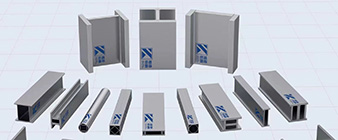Corrosion resistance:
316L stainless steel is extremely resistant to general corrosion, stick and crevice corrosion.
The addition of molybdenum in the alloy composition enhances the material’s resistance to localized corrosion, especially in chloride-containing environments.
This makes 316L a popular choice for applications in the marine, chemical and food processing industries.
Mechanical Properties:
316L stainless steel has good mechanical strength, with a typical tensile strength range of 485-620 MPa and a yield strength range of 170-450 MPa.
It exhibits excellent ductility, with crack elongation typically around 40-60%.
The material’s strength and ductility make it suitable for structural applications and the manufacture of complex components.
Thermal Performance:
316L stainless steel has a relatively low thermal conductivity compared to carbon steel, which may be beneficial in applications requiring thermal insulation.
The thermal expansion coefficient of the material is slightly higher than that of carbon steel, and this coefficient should be considered during the design and manufacturing process.
Solderability:
316L stainless steel is generally considered to have good weldability, but welding parameters need to be carefully controlled to maintain the material’s corrosion resistance and mechanical properties in the heated areas.
Proper preheating, post-weld heat treatment, and use of appropriate filler materials are critical to successfully welding 316L stainless steel.
Low and high temperature performance:
316L stainless steel maintains its mechanical properties and corrosion resistance at cryogenic temperatures, making it suitable for applications in the liquefied gas and aerospace industries.
At high temperatures, 316L stainless steel exhibits good oxidation resistance, making it suitable for use in furnaces, heat exchangers and other high temperature applications.
Magnetic Properties: 316L stainless steel is a non-magnetic material, which is an advantage in applications where magnetic properties are undesirable, such as medical devices and electronics.
The combination of excellent corrosion resistance, good mechanical properties and versatile thermal and physical properties make 316L stainless steel a popular choice for a wide range of industrial, commercial and construction applications. The performance advantages must be weighed against the higher cost compared to carbon steel.
-
 2024-9-15 Weathering steel structural steel profiles
2024-9-15 Weathering steel structural steel profiles -
 2024-9-20 What are the advantages of S690 steel in construction engineering compared with conventional steel?
2024-9-20 What are the advantages of S690 steel in construction engineering compared with conventional steel? -
 2024-9-16 UNS S31803 stainless steel Hollow Sections and steel profiles of innovative applications
2024-9-16 UNS S31803 stainless steel Hollow Sections and steel profiles of innovative applications -
 2024-9-19 1.4539 stainless steel hollow structural profile
2024-9-19 1.4539 stainless steel hollow structural profile -
 2024-3-22 Two official standards for laser welded profiles
2024-3-22 Two official standards for laser welded profiles -
 2024-9-21 fabrication of S690 steel structures
2024-9-21 fabrication of S690 steel structures -
 2024-9-27 What are the common applications of 318LN (1.4462) stainless steel hollow structural sections?
2024-9-27 What are the common applications of 318LN (1.4462) stainless steel hollow structural sections?



